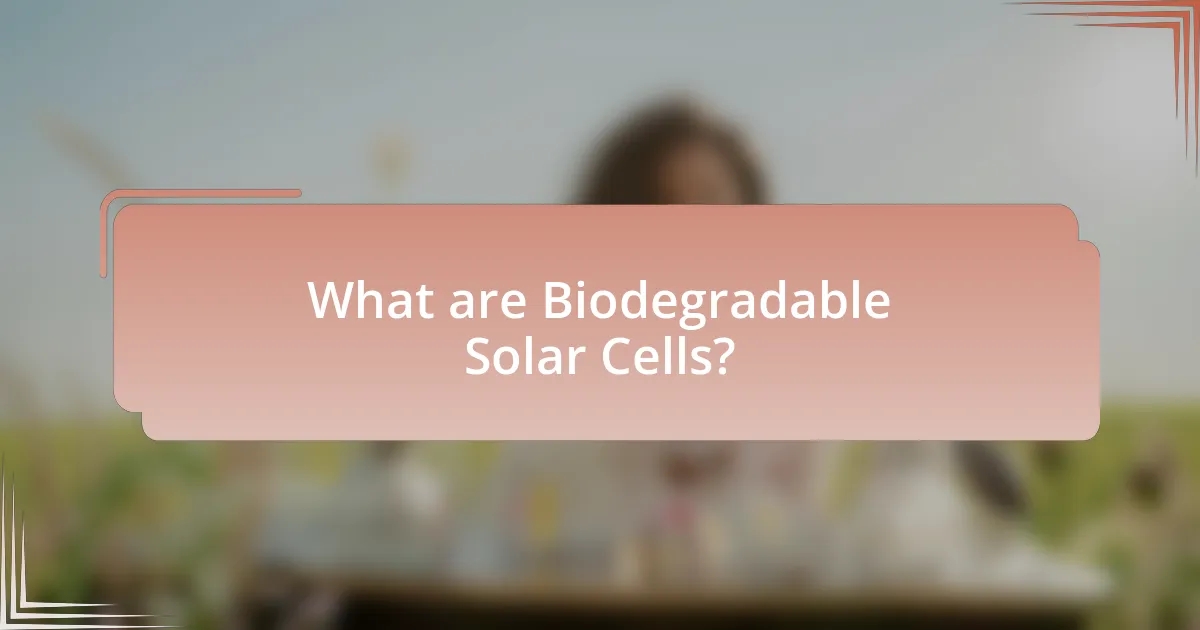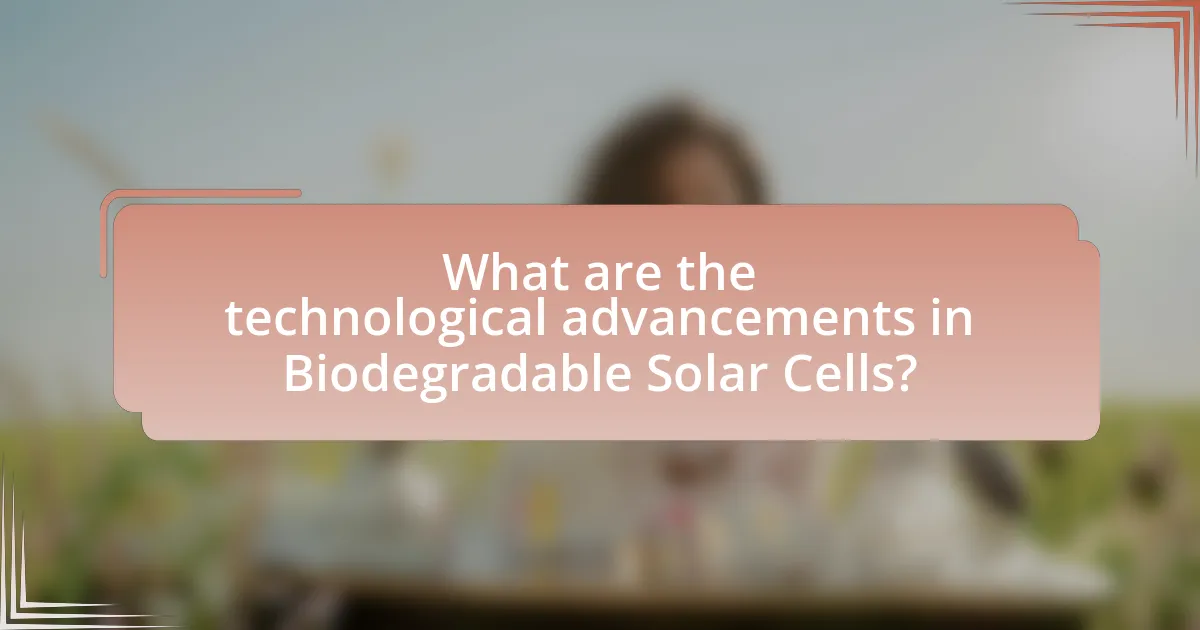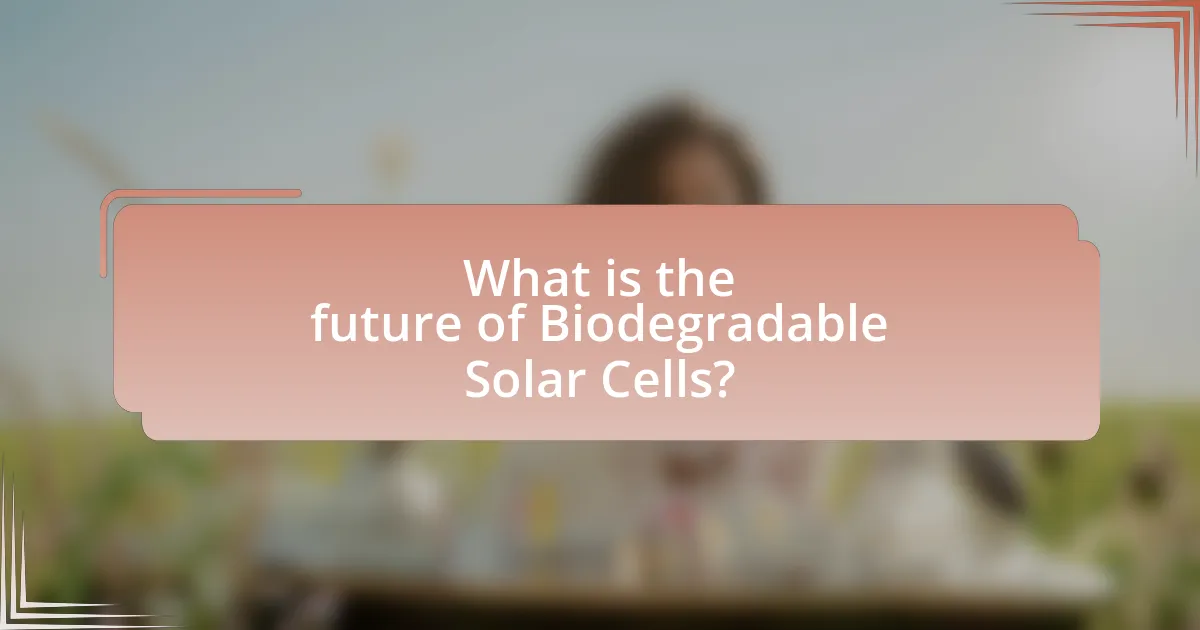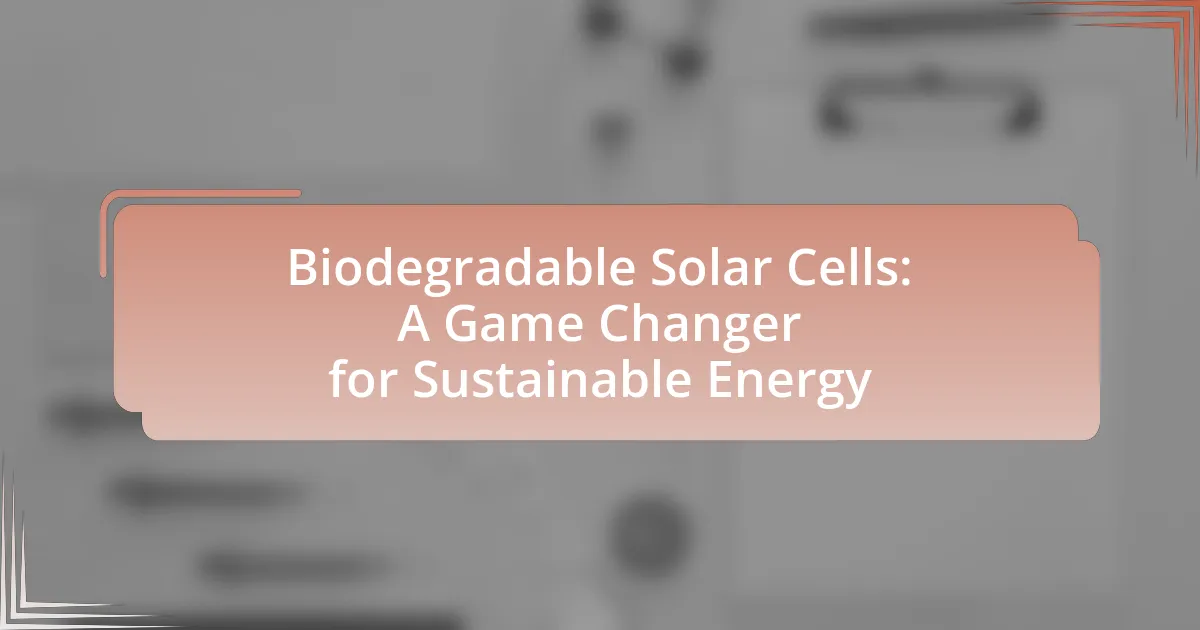Biodegradable solar cells are innovative photovoltaic devices made from organic materials that naturally decompose, offering a sustainable alternative to traditional silicon-based solar cells. This article explores the differences between biodegradable and conventional solar cells, highlighting their environmental benefits, such as reduced waste and lower carbon footprints. It discusses the materials used in their production, recent technological advancements that enhance efficiency, and the challenges faced in the market, including cost and performance issues. Additionally, the article examines the role of policy and consumer awareness in promoting the adoption of biodegradable solar cells, emphasizing their potential to revolutionize sustainable energy solutions.

What are Biodegradable Solar Cells?
Biodegradable solar cells are photovoltaic devices made from organic materials that can decompose naturally in the environment. These solar cells utilize materials such as polymers and small organic molecules, which not only generate electricity from sunlight but also break down into non-toxic components over time, reducing environmental impact. Research indicates that biodegradable solar cells can be produced with lower energy inputs compared to traditional silicon-based solar cells, making them a more sustainable option for energy generation.
How do Biodegradable Solar Cells differ from traditional solar cells?
Biodegradable solar cells differ from traditional solar cells primarily in their materials and environmental impact. Traditional solar cells typically use silicon and other non-biodegradable materials, which can contribute to waste and pollution at the end of their life cycle. In contrast, biodegradable solar cells are made from organic materials that can decompose naturally, reducing environmental harm. Research indicates that biodegradable solar cells can maintain comparable efficiency levels while offering a sustainable alternative, as they can break down within a few months to years, unlike traditional cells that can take decades to decompose.
What materials are used in Biodegradable Solar Cells?
Biodegradable solar cells primarily utilize organic materials such as polymers and small organic molecules. These materials include poly(3-hexylthiophene) (P3HT) and fullerene derivatives, which are known for their light-absorbing properties and ability to convert sunlight into electricity. Additionally, natural materials like cellulose and starch are being explored for their potential in creating environmentally friendly solar cell components. Research indicates that these biodegradable materials can effectively reduce environmental impact while maintaining efficiency in energy conversion.
How does the biodegradability of these cells impact their lifecycle?
The biodegradability of biodegradable solar cells significantly shortens their lifecycle by allowing them to decompose naturally after their useful life, reducing environmental waste. This characteristic enables the cells to break down into non-toxic components, which can be assimilated back into the ecosystem, thereby minimizing landfill contributions and pollution associated with traditional solar cells. Research indicates that biodegradable materials can reduce the carbon footprint of solar energy systems, as they do not persist in the environment like conventional materials, which can take hundreds of years to decompose.
Why are Biodegradable Solar Cells important for sustainable energy?
Biodegradable solar cells are important for sustainable energy because they reduce environmental impact while providing renewable energy solutions. Traditional solar cells often contain toxic materials that can harm ecosystems when disposed of improperly. In contrast, biodegradable solar cells are designed to decompose naturally, minimizing waste and pollution. Research indicates that these cells can be made from organic materials, which not only lowers their carbon footprint but also enhances their sustainability. For instance, studies have shown that biodegradable solar cells can maintain efficiency levels comparable to conventional cells while offering a more eco-friendly lifecycle.
What environmental benefits do Biodegradable Solar Cells provide?
Biodegradable solar cells provide significant environmental benefits by reducing waste and minimizing pollution. Unlike traditional solar cells, which often contain toxic materials like cadmium and lead, biodegradable solar cells are made from organic materials that can decompose naturally, thus preventing harmful substances from entering landfills and ecosystems. Research indicates that the use of biodegradable materials can lower the carbon footprint associated with solar energy production, as these materials require less energy to manufacture and can be produced sustainably. Additionally, their ability to break down reduces the long-term environmental impact, contributing to a circular economy in renewable energy technologies.
How do Biodegradable Solar Cells contribute to reducing waste?
Biodegradable solar cells contribute to reducing waste by being designed to decompose naturally at the end of their life cycle, unlike traditional solar cells that often end up in landfills. This decomposition process minimizes environmental impact and reduces the accumulation of electronic waste, which is a growing global concern. Research indicates that biodegradable materials can break down into non-toxic components, thus preventing harmful substances from leaching into the environment. For instance, studies have shown that using organic materials in solar cell production can significantly lower the carbon footprint associated with manufacturing and disposal, further supporting waste reduction efforts.

What are the technological advancements in Biodegradable Solar Cells?
Technological advancements in biodegradable solar cells include the development of organic photovoltaic materials that are derived from natural sources, such as plant-based polymers and proteins. These materials enhance the efficiency and stability of solar cells while ensuring they can decompose safely in the environment. Recent research has demonstrated that incorporating nanomaterials, like cellulose nanofibers, can improve the light absorption and overall performance of these solar cells. For instance, a study published in the journal “Nature Materials” by researchers from the University of Cambridge highlighted that biodegradable solar cells can achieve efficiencies comparable to traditional silicon-based cells while being environmentally friendly. Additionally, advancements in printing techniques have enabled the mass production of these cells, making them more accessible and cost-effective for widespread use.
How have recent innovations improved the efficiency of Biodegradable Solar Cells?
Recent innovations have significantly improved the efficiency of biodegradable solar cells by enhancing their light absorption and charge transport properties. For instance, the development of new organic materials, such as non-fullerene acceptors, has led to higher power conversion efficiencies, with some biodegradable solar cells achieving efficiencies over 15%. Additionally, advancements in the fabrication techniques, like roll-to-roll processing, have allowed for more uniform layer deposition, which optimizes the active layer’s morphology and increases overall performance. These innovations demonstrate a clear trend towards making biodegradable solar cells not only more efficient but also more viable for commercial applications in sustainable energy.
What role do nanomaterials play in enhancing Biodegradable Solar Cells?
Nanomaterials significantly enhance biodegradable solar cells by improving their efficiency, stability, and overall performance. These materials, such as nanoparticles and nanostructures, increase the surface area for light absorption and facilitate better charge transport within the solar cell. For instance, the incorporation of titanium dioxide nanoparticles has been shown to enhance light harvesting and electron mobility, leading to higher energy conversion efficiencies. Research indicates that using nanomaterials can boost the power conversion efficiency of biodegradable solar cells by up to 30%, making them a viable alternative for sustainable energy solutions.
How is the manufacturing process evolving for these solar cells?
The manufacturing process for biodegradable solar cells is evolving through advancements in materials and techniques that enhance efficiency and sustainability. Recent developments include the use of organic materials and non-toxic components, which reduce environmental impact while maintaining performance. For instance, researchers have successfully integrated biodegradable polymers that decompose without leaving harmful residues, as demonstrated in studies published in journals like Nature Materials. These innovations not only improve the ecological footprint of solar cell production but also aim to lower costs and increase scalability, making biodegradable solar cells a viable alternative in the renewable energy market.
What challenges do Biodegradable Solar Cells face in the market?
Biodegradable solar cells face significant challenges in the market, primarily related to efficiency, cost, and durability. Current biodegradable materials often exhibit lower energy conversion efficiencies compared to traditional silicon-based solar cells, which limits their competitiveness. Additionally, the production costs of biodegradable solar cells can be higher due to the complexity of sourcing and processing organic materials, making them less appealing to manufacturers and consumers. Furthermore, concerns about the long-term stability and lifespan of biodegradable solar cells pose a challenge, as they may degrade faster than conventional options, impacting their viability for widespread adoption. These factors collectively hinder the market penetration of biodegradable solar cells despite their potential for sustainable energy solutions.
What are the economic barriers to widespread adoption?
The economic barriers to widespread adoption of biodegradable solar cells include high initial production costs, limited manufacturing scalability, and competition with established solar technologies. High production costs stem from the advanced materials and processes required to create biodegradable components, which can exceed those of traditional solar cells. Limited manufacturing scalability restricts the ability to produce biodegradable solar cells in large quantities, leading to higher per-unit costs. Additionally, established solar technologies benefit from economies of scale and established supply chains, making it challenging for biodegradable alternatives to compete on price and availability. These factors collectively hinder the market penetration of biodegradable solar cells despite their potential environmental benefits.
How do performance issues compare to traditional solar technologies?
Performance issues in biodegradable solar cells generally involve lower efficiency and shorter lifespan compared to traditional solar technologies, which typically offer higher energy conversion rates and durability. For instance, traditional silicon-based solar panels achieve efficiencies of around 15-22%, while biodegradable alternatives often range between 5-10%. Additionally, traditional solar technologies can last 25 years or more, whereas biodegradable cells may degrade within a few years due to environmental factors. These differences highlight the trade-offs between sustainability and performance in solar energy solutions.

What is the future of Biodegradable Solar Cells?
The future of biodegradable solar cells is promising, with advancements in materials science and sustainability driving their development. Researchers are focusing on organic photovoltaic materials that can decompose naturally, reducing environmental impact. For instance, studies indicate that biodegradable solar cells can be made from materials like cellulose and proteins, which not only provide efficient energy conversion but also minimize waste. The global push for renewable energy solutions and stricter regulations on plastic waste further enhance the viability of biodegradable solar cells in the market.
How can policy and regulation support the growth of Biodegradable Solar Cells?
Policy and regulation can support the growth of biodegradable solar cells by providing financial incentives, establishing standards for production, and promoting research and development. Financial incentives, such as tax credits or grants, can lower the cost barrier for manufacturers and encourage investment in biodegradable technologies. Establishing production standards ensures that biodegradable solar cells meet environmental and performance criteria, fostering consumer trust and market acceptance. Additionally, promoting research and development through government funding can accelerate innovation in biodegradable materials and manufacturing processes, leading to more efficient and commercially viable products. For instance, the European Union’s Green Deal aims to boost sustainable technologies, which includes support for biodegradable solar cell initiatives, demonstrating a commitment to integrating such innovations into the energy market.
What incentives exist for companies to invest in Biodegradable Solar Cell technology?
Companies have several incentives to invest in biodegradable solar cell technology, primarily driven by environmental sustainability, regulatory support, and market demand for eco-friendly products. The growing emphasis on reducing carbon footprints and waste encourages firms to adopt biodegradable solutions, aligning with global sustainability goals. Additionally, governments worldwide are increasingly offering tax incentives, grants, and subsidies for renewable energy technologies, including biodegradable solar cells, to promote innovation and reduce reliance on fossil fuels. Market research indicates that consumers are willing to pay a premium for sustainable products, which can lead to increased sales and brand loyalty for companies that invest in this technology. Furthermore, advancements in biodegradable materials can lead to cost reductions in production, enhancing profitability.
How can consumer awareness influence the adoption of Biodegradable Solar Cells?
Consumer awareness significantly influences the adoption of biodegradable solar cells by driving demand for sustainable energy solutions. When consumers are informed about the environmental benefits and efficiency of biodegradable solar cells, they are more likely to choose these products over traditional solar technologies. Research indicates that 70% of consumers prefer eco-friendly products, which highlights the potential market for biodegradable options. Increased awareness can lead to higher sales, prompting manufacturers to invest in research and development, ultimately accelerating the transition to sustainable energy sources.
What practical steps can be taken to implement Biodegradable Solar Cells effectively?
To implement biodegradable solar cells effectively, the following practical steps should be taken: first, develop materials that are both efficient in energy conversion and environmentally friendly, such as organic photovoltaics made from natural polymers. Research indicates that materials like perovskite and organic compounds can achieve high efficiency while being biodegradable. Second, establish manufacturing processes that minimize waste and energy consumption, utilizing techniques like roll-to-roll printing, which has been shown to reduce production costs and environmental impact. Third, create a robust recycling program to ensure that any non-biodegradable components are properly processed, thereby reducing landfill waste. Lastly, engage in public awareness campaigns to educate consumers about the benefits and availability of biodegradable solar cells, as studies show that consumer acceptance is crucial for the adoption of new technologies.
What best practices should manufacturers follow when producing Biodegradable Solar Cells?
Manufacturers should prioritize the use of non-toxic, renewable materials when producing biodegradable solar cells. This approach ensures that the solar cells can decompose safely without releasing harmful substances into the environment. Additionally, manufacturers should implement efficient production processes that minimize waste and energy consumption, aligning with sustainability goals. Research indicates that using organic photovoltaic materials, such as polymers derived from natural sources, can enhance biodegradability while maintaining efficiency. Furthermore, manufacturers should conduct lifecycle assessments to evaluate the environmental impact of their products from production to disposal, ensuring that the entire process supports sustainability.
How can consumers choose the right Biodegradable Solar Cell products for their needs?
Consumers can choose the right biodegradable solar cell products by evaluating their efficiency, environmental impact, and compatibility with existing systems. Efficiency ratings indicate how well a solar cell converts sunlight into electricity, which is crucial for meeting energy needs. Environmental impact assessments reveal the materials used and the biodegradability of the product, ensuring it aligns with sustainability goals. Compatibility with existing solar systems is essential for seamless integration and optimal performance. Research shows that biodegradable solar cells can reduce waste and carbon footprint, making them a viable option for eco-conscious consumers.


